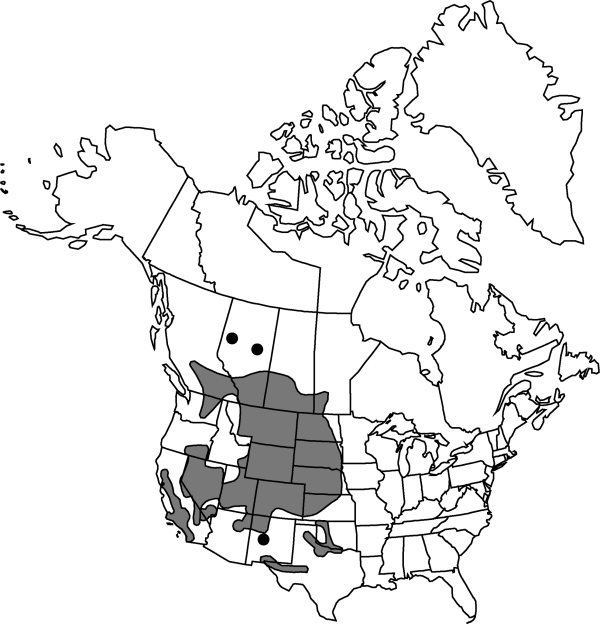Difference between revisions of "Atriplex argentea"
Gen. N. Amer. Pl. 1: 198. 1818.
FNA>Volume Importer |
FNA>Volume Importer |
||
| Line 84: | Line 84: | ||
|publication year=1818 | |publication year=1818 | ||
|special status= | |special status= | ||
| − | |source xml=https://jpend@bitbucket.org/aafc-mbb/fna-data-curation.git/src/ | + | |source xml=https://jpend@bitbucket.org/aafc-mbb/fna-data-curation.git/src/f6b125a955440c0872999024f038d74684f65921/coarse_grained_fna_xml/V4/V4_671.xml |
|genus=Atriplex | |genus=Atriplex | ||
|subgenus=Atriplex subg. Obione | |subgenus=Atriplex subg. Obione | ||
Revision as of 20:02, 24 September 2019
Herbs, simple or freely branched, 0.5–6 dm; branches rather stout, angled, scurfy when young. Leaves often opposite proximally, petiolate or distal bracteate ones subsessile, blade lance-ovate, lanceolate, deltoid, or cordate, 5–75 × 4–50(–75) mm, base subhastate or obtuse to acute, margin entire or essentially so, sometimes closely repand-dentate, apex obtuse to acute or rounded, scurfy (glabrous). Flowers in axillary glomerules and terminal, interrupted spikes. Staminate flowers borne in distal axils, or in short dense spikes or panicles, or intermixed with pistillate, with 4–5-parted calyx. Fruiting bracteoles sessile, subsessile, or stipitate (stipe 0.5–5 mm), cuneate-orbicular, (2.5–)4–11.2 × 2–8.8(–14) mm, margin foliaceous below apex, subentire or dentate to laciniate, face smooth, tuberculate, or crested, processes sometimes again toothed, teeth then aligned with axis of process. Seeds brown, 1.5–2 mm wide; radicle superior or lateral. 2n = 18, 36, 54.
Distribution

North America, Mexico.
Discussion
Varieties 5 (5 in the flora).
Herbarium materials have tended to represent a catchall for annual specimens not readily assignable to other taxa. Indeed, the distinguishing features of the Atriplex argentea complex are shared singly and often in combination with other taxa. Only by use of combinations of features can this taxon be defined. Those features, with much variation, center around the broad, typically ovate to deltoid leaf blades (often definitely 3-veined) and more-or-less compressed, sessile to subsessile (or short stipitate), fruiting bracteoles on which the marginal processes, or teeth, are mainly aligned with the plane compression, and with the faces quite smooth to variously appendaged. Still some specimens are apparently intermediate with other species, especially with the closely allied A. saccaria, with which it is at least partially sympatric.
Selected References
None.
Lower Taxa
Key
| 1 | Plants low, rounded, mainly 1-3(-4.5) dm; fruiting bracteoles sessile or rarely some short stipitate, the appendages mainly acuminate or acute-attenuate; Nevada and adjacent se California, se Oregon | > 2 |
| 1 | Plants rather strict and often taller, mainly 2-4(-5) dm; fruiting bracteoles, at least some, short stipitate; appendages acute to less commonly acuminate to attenuate; other distribution | > 3 |
| 2 | Leaf blades typically, but not always, constricted to the petiole; herbage merely scurfy, or with elongate trichomes mainly on the fruiting bracteoles; Nevada (except the southern part), and adjacent se California and se Oregon | Atriplex argentea var. hillmanii |
| 2 | Leaf blades typically, if not always, cuneate to a winged petiole or merely sessile base; herbage copiously covered with elongate trichomes throughout, or mostly on the stems and fruiting bracteoles; Nye County, Nevada and adjacent Inyo County, California | Atriplex argentea var. longitrichoma |
| 3 | Leaf blades elliptic to oval, attenuate to a cuneate base; sw Colorado, se Utah, and nw New Mexico | Atriplex argentea var. rydbergii |
| 3 | Leaf blades triangular-ovate to oval, base broadly obtuse to acute or less commonly cuneate; various or other distribution | > 4 |
| 4 | Distal leaves short petiolate; proximalmost leaves alternate; plants mostly less than 4 dm; British Columbia to Manitoba, s through Montana, North Dakota, South Dakota, Wyoming, Nebraska, Idaho, Utah, e Nevada, Colorado, w Kansas, ne Arizona, nw New Mexico | Atriplex argentea var. argentea |
| 4 | Distal leaves sessile; proximalmost leaves opposite; plants mostly over 4 dm; California, s Nevada, Arizona, New Mexico, w Oklahoma, w and n Texas | Atriplex argentea var. mohavensis |